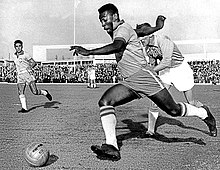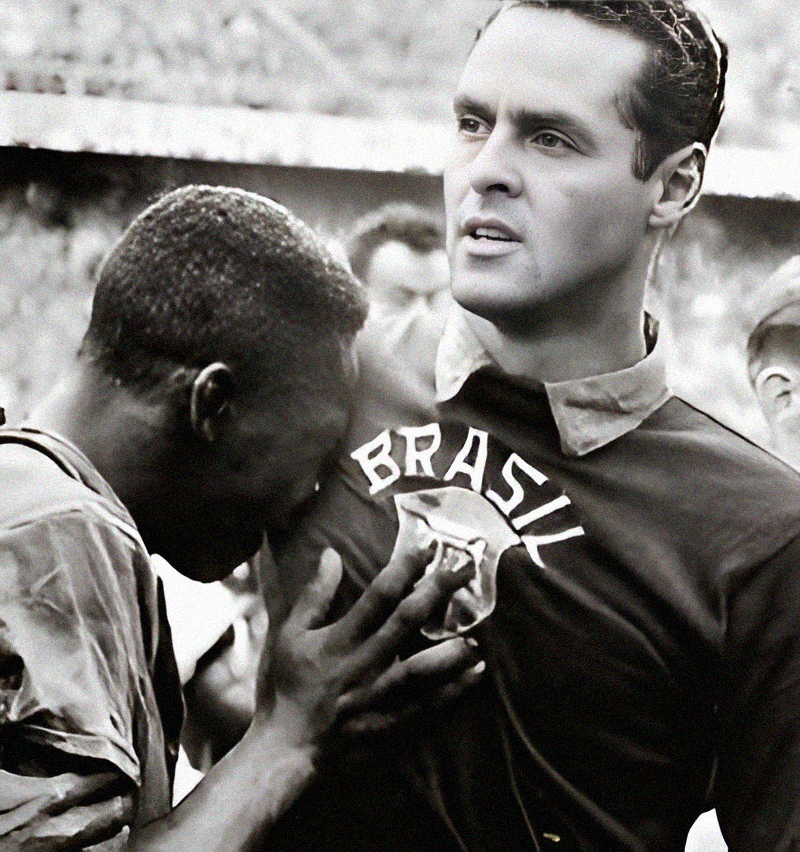Santos

The marks that Pelé left inside the Maracanã Stadium
In 1956, de Brito took Pelé to
Santos, an industrial and port city in the state of
São Paulo, to try out for professional club
Santos Futebol Clube telling the directors at Santos that the 15-year-old would be "the greatest football player in the world."
During his time at Santos, Pelé played alongside many gifted players, including
Zito,
Pepe, and
Coutinho; the latter partnered him in numerous one-two plays, attacks, and goals.
Pelé made his debut for Santos in 7 September 1956, scoring one goal in a 7–1 friendly victory over
Corinthians.
When the 1957 season started, Pelé was given a starting place in the first team and, at the age of just 16, became the top scorer in the league. Just ten months after signing professionally, the teenager was called up to the
Brazil national team. After the
World Cup in 1962, wealthy European clubs such as Real Madrid, Juventus and Manchester United tried to sign the young player, but the government of Brazil declared Pelé an "official national treasure" to prevent him from being transferred out of the country.
Pelé won his first major title with Santos in 1958 as the team won the
Campeonato Paulista; Pelé would finish the tournament as top scorer with an incredible 58 goals,
a record that stands today. A year later,
O Rei would help the team earn their first victory in the
Torneio Rio-São Paulo with a 3-0 over Vasco da Gama.
However, Santos was unable to retain the Paulista title. In 1960, Pelé scored 33 goals to help his team regain the Campeonato Paulista trophy but lost out on the Rio-São Paulo tournament after finishing in a disappointing 8th place.
Another 47 goals from Pelé saw Santos retain the Campeonato Paulista. The club went on to win the
Taça Brasil that same year, crushing
Bahia in the finals; Pelé finished as top scorer of the tournament with 9 goals. The victory allowed Santos to participate in the
Copa Libertadores, the most prestigious club tournament in the Western hemisphere.
Santos' most successful club season started in
1962;
the team was seeded in Group 1 alongside
Cerro Porteño and
Deportivo Municipal, winning every match of their group but one (a 1-1 away tie vs Cerro), with Pelé scoring his first goal in a brace against Cerro. Santos defeated
Universidad Católica in the semifinals and met
defending champions Peñarol in the finals in which Pelé scored another brace in the playoff match to secure the first title for a Brazilian club. Pelé finished as the second best scorer of the competition with 4 goals. That same year, Santos would defend, with success, the Campeonato Brasiliero (with 37 goals from Pelé), the Taça Brasil (Pelé scoring four goals in the final series against Botafogo), and win the
1962 Intercontinental Cup (Pelé scoring five goals in the series).
As the defending champions, Santos qualified automatically to the semifinal stage of the
1963 Copa Libertadores. The
ballet blanco managed to retain the title in spectacular fashion after impressive victories over
Botafogo and
Boca Juniors. Pelé helped Santos overcome a Botafogo team that contained legends such as
Garrincha and
Jairzinho with an agonizing last-minute goal in the first leg of the semifinals and bring the match to 1-1. In the second leg, Pelé produced one of his best performances as a footballer with a
hat-trick in the
Estádio do Maracanã as Santos crushed Botafogo 0-4 in the second leg. Appearing in their second consecutive final, Santos started the series by winning 3-2 in the first leg and defeating the Boca Juniors of
José Sanfilippo and
Antonio Rattín 1-2 in
La Bombonera, with another goal from Pelé, becoming the first (and so far only) Brazilian team to lift the Copa Libertadores in Argentine soil. Pelé finished the tournament as the topscorer runner-up with 5 goals. Santos lost the Campeonato Paulista after finishing in third place but went on to win the Rio-São Paulo tournament after an impressive 0-3 win over Flamengo in the final, with Pelé providing one goal in the match. Pelé would also help Santos retain the Intercontinental Cup and the Taça Brasil.
Santos tried to defend their title again in
1964 but they were thoroughly beaten in both legs of the semifinals by
Independiente. Santos won again the Campeonato Paulista, with Pelé netting 34 goals. The club also shared the Rio-São Paulo title with Botafogo and win the Taça Brasil for the fourth consecutive year. The
Santistas would try to resurge in 1965 by winning, for the 9th time, the Campeonato Paulista and the Taça Brasil. In the
1965 Copa Libertadores, Santos started convincingly by winning every match of their group in the first round. In the semifinals, Santos met Peñarol in a rematch of the 1962 final. After two legendary matches,
a playoff was needed to break the tie. Unlike 1962, Peñarol came out on top and eliminated Santos 2-1.
Pelé would, however, finish as the topscorer of the tournament with eight goals. This proved to be the start of a decline as Santos failed to retain the Torneio Rio-São Paulo, finishing in an embarrassing 9th place (second to last).
In 1966, Pelé and Santos also failed to retain the Taça Brasil as
O Rei's goals weren't enough to prevent a 9-4 routing by Cruzeiro in the final series. Although Santos won the Campeonato Paulista in 1967, 1968 and 1969, Pelé became less and less a contributing factor to the
Santistas now-limited success. On 19 November 1969, Pelé scored his 1000th goal in all competitions. This was a highly anticipated moment in Brazil.
The goal, called popularly
O Milésimo (The Thousandth), occurred in a match against
Vasco da Gama, when Pelé scored from a
penalty kick, at the
Maracanã Stadium.
Pelé states that his most beautiful goal was scored at
Rua Javari stadium on a
Campeonato Paulista match against São Paulo rival
Juventus on 2 August 1959. As there is no video footage of this match, Pelé asked that a computer animation be made of this specific goal.
In March 1961, Pelé scored the
gol de placa (goal worthy of a plaque), a goal against
Fluminense at the Maracanã which was regarded as so spectacular that a plaque was commissioned with a dedication to
the most beautiful goal in the history of the Maracanã.
Pelé’s electrifying play and penchant for spectacular goals made him a star around the world.
His team Santos toured internationally in order to take full advantage of his popularity. In 1967, the two factions involved in the
Nigerian Civil War agreed to a 48-hour
ceasefire so they could watch Pelé play an
exhibition game in
Lagos.
New York Cosmos
After the 1972 season (his 17th with Santos), Pelé retired from Brazilian club football although he continued to occasionally suit up for Santos in official competitive matches. Two years later, he came out of semi-retirement to sign with the
New York Cosmos of the
North American Soccer League (NASL) for the 1975 season. Though well past his prime at this point, Pelé is credited with significantly increasing public awareness and interest in soccer in the United States. He led the Cosmos to the 1977 NASL championship, in his third and final season with the club.
On 1 October 1977, Pelé closed out his legendary career in an exhibition match between the Cosmos and Santos. Santos arrived in New York and New Jersey after previously defeating the
Seattle Sounders 2–0. The match was played in front of a capacity crowd at
Giants Stadium and was televised in the United States on ABC's
Wide World of Sports as well as throughout the world. Pelé's father and wife both attended the match. Pelé gave a brief pre-match speech during which he asked the crowd to say the word "love" with him three times. He played the first half for the Cosmos and the second half for Santos.
Reynaldo scored the first goal for Santos, kicking the ball into the net after it had deflected off the crossbar. Pelé then scored his final goal on a direct free kick, driving the ball past the diving Santos goalkeeper. At halftime, the Cosmos retired Pelé's number 10. Pelé presented his Cosmos shirt to his father, who was escorted to the field by Cosmos captain
Werner Roth. During the second half, Cosmos striker
Ramon Mifflin, who had replaced Pelé when he switched sides at halftime, scored on a deflected cross, and the Cosmos won the match 2–1. After the match, Pelé was embraced by the Cosmos players, including longtime rival
Giorgio Chinaglia, and then ran around the field while holding an American flag in his left hand and a Brazilian flag in his right hand. Pelé was soon lifted by several Cosmos players and carried around the field.








